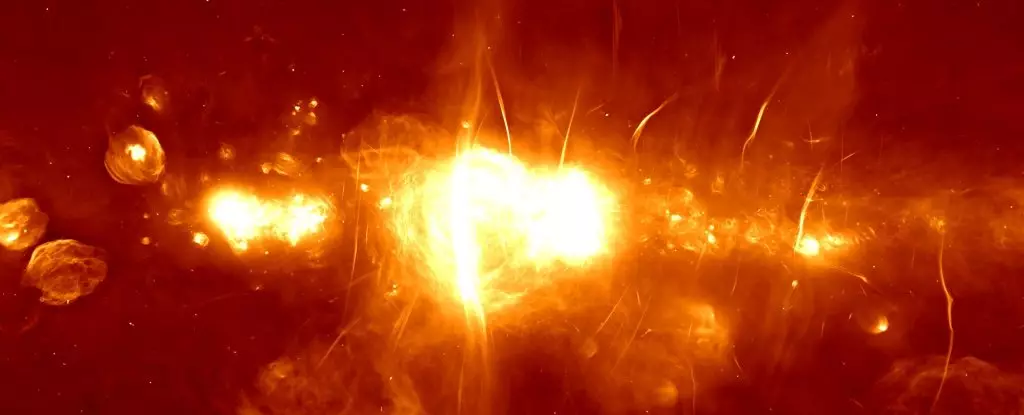In the heart of our Milky Way galaxy, a phenomenon is unfolding that challenges our understanding of cosmic structures. Recent research led by astronomer Kai Yang at Shanghai Jiao Tong University has unveiled a groundbreaking discovery in the Central Molecular Zone (CMZ), an area teeming with molecular gas and dust surrounding the supermassive black hole. What initially began as a quest to scrutinize known entities evolved into an astonishing revelation: long, slender filaments of gas, dubbed “slim filaments,” have emerged, displaying characteristics never before seen within the astronomical community.
This discovery is not simply a footnote in galactic studies; it is a pivotal moment that can reshape our comprehension of the material dynamics happening in the CMZ. Historically, astronomers have encountered various filaments around galactic centers, but Yang and his team have unearthed structures that operate through unprecedented mechanisms. The implications of these slim filaments may profoundly enhance our understanding of gas dispersion and molecular behavior in one of the galaxy’s most dynamic regions.
Inside the Turbulent CMZ
The CMZ itself is a chaotic landscape, characterized by densely packed clouds of gas that can stretch across 2,000 light-years. It is estimated to house around 80 percent of the galaxy’s dense gas and a striking 5 percent of all molecular gas—a statistic that emphasizes its importance in the overarching galactic ecosystem. The conditions here are intense: clouds race through space at velocities exceeding 100 kilometers per second, generating turbulence and shock waves that sculpt the very fabric of galactic matter.
Interestingly, the CMZ creates a complex environment that complicates observational efforts. Due to the thickness and opacity of these gas clouds, traditional observation methods can struggle to penetrate and reveal the processes occurring within. Utilizing the Atacama Large Millimeter/submillimeter Array (ALMA) in Chile, Yang’s team directed their focus towards silicon monoxide, a remarkable tracer for discerning shock activity in space. The cosmic dance that evolved from their observations not only confirmed the presence of gas but also showcased a peculiar network of long, thin filaments that deviated from any known cosmic structures.
Unraveling Cosmic Tornadoes
The slim filaments, unfortunately for traditional paradigms, transcended the expectations of the researchers. Depicted with striking precision in ALMA images, these filaments consist of complex organic molecules and exhibit a host of unexpected velocity distributions. This suggests that their underlying dynamics are distinctly turbulent, bearing a striking resemblance to earthly tornadoes or dust devils—well-known meteorological phenomena.
Xing Lu, a fellow astronomer from the Shanghai Astronomical Observatory, conveys the magnitude of this discovery aptly when stating, “We can envision these as space tornadoes: they are violent streams of gas, they dissipate shortly, and they distribute materials into the environment efficiently.” This characterization reverberates throughout the astrophysical community, infusing discussions of galactic dynamics with a refreshing perspective that underscores the chaotic yet systematic behavior of cosmic gases.
The Formation Enigma
Despite the exhilarating findings regarding the presence and characteristics of slim filaments, the precise mechanisms behind their formation remain elusive. Researchers speculate that the chaotic interactions, particularly shock waves resulting from collisions in the CMZ, may play a crucial role. Such shocks might generate turbulence that not only heats complex molecules into their gas phase but also strategically releases them into the interstellar medium.
The significance here cannot be overstated. If slim filaments prove to be abundant throughout the CMZ, they could elucidate much about the material recycling processes within this dynamic environment. The researchers postulate that the existence of these structures could signify an entirely distinct class from the denser gas filaments traditionally associated with molecular clouds. They may emerge as a product of complex interactions between molecular clouds and the tumultuous environment of shock waves.
Implications for Galactic Evolution
As our understanding deepens, the implications of slim filaments extend far beyond the boundaries of the CMZ. Their efficiency in redistributing materials within the galactic ecosystem might provide critical insights into how galaxies evolve over time. What Yang and his team have unlocked may very well be an essential puzzle piece in the broader narrative of cosmic history.
Far from being a mere academic exercise, this research stands as a testament to humanity’s ceaseless curiosity about the universe. It beckons further inquiries into the fundamental processes that govern the dynamics of our galaxy. As we refine our observational tools and analytical methods, who knows what captivating discoveries await us in the cosmos?


Leave a Reply